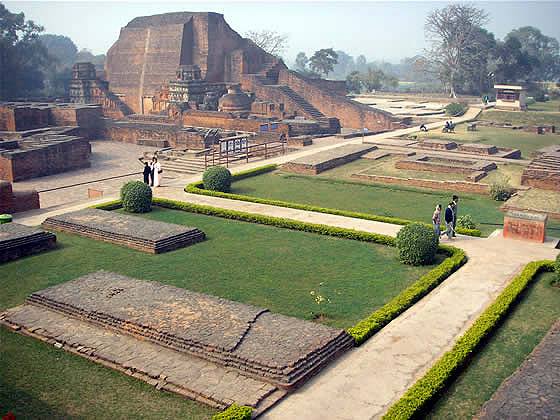|
Pramāṇa-samuccaya
The ''Pramāṇa-samuccaya'' (''Compendium of Epistemology'') is a Buddhist philosophical treatise focusing on epistemology ( pramana) by Dignāga, an Indian Buddhist Buddhism, also known as Buddhadharma and Dharmavinaya, is an Indian religion and List of philosophies, philosophical tradition based on Pre-sectarian Buddhism, teachings attributed to the Buddha, a wandering teacher who lived in the 6th or ... logician and epistemologist who lived from c. 480 to c. 540 . The ''Pramāṇa-samuccaya'' exists in two Tibetan translations by Vasudhararaksita and Kanakavarman respectively. The original Sanskrit was initially thought to be lost by modern scholars, but then a manuscript of the commentary by Jinendrabuddhi was discovered. Modern scholars working with The China Tibetology Research Center and the Austrian Academy of Sciences are currently working to extract and reconstruct the Sanskrit root text of the ''Pramāṇasamuccaya'' from the commentary in which it is em ... [...More Info...] [...Related Items...] OR: [Wikipedia] [Google] [Baidu] |
Dignāga
Dignāga (also known as ''Diṅnāga'', ) was an Indian Buddhist philosopher and logician. He is credited as one of the Buddhism, Buddhist founders of Indian logic (''hetu vidyā'') and Buddhist atomism, atomism. Dignāga's work laid the groundwork for the development of deductive logic in India and created the first system of Buddhist logic and epistemology (pramāṇa). According to Georges Dreyfus, Georges B. Dreyfus, his philosophical school brought about an Indian "epistemological turn" and became the "standard formulation of Buddhist logic and epistemology in India and Tibet." Dignāga's thought influenced later Buddhist philosophers like Dharmakirti and also Hindu thinkers of the Nyaya school. Dignāga's epistemology accepted only "perception" (Pramana#Hinduism, ''pratyaksa'') and "inference" (''anumāṇa'') as valid instruments of knowledge and introduced the widely influential theory of "exclusion" (''apoha'') to explain linguistic meaning.Arnold, Dan. The Philosophi ... [...More Info...] [...Related Items...] OR: [Wikipedia] [Google] [Baidu] |
Buddhist Logic
Buddhist logico-epistemology is a term used in Western scholarship to describe Buddhism, Buddhist systems of ' (Epistemology, epistemic tool, valid cognition) and ' (reasoning, logic). While the term may refer to various Buddhist systems and views on reasoning and epistemology, it is most often used to refer to the work of the "Epistemological school" (Sanskrit: ), i.e. the school of Dignāga, Dignaga and Dharmakirti which developed from the 5th through 7th centuries and remained the main system of Buddhist reasoning until the Decline of Buddhism in the Indian subcontinent, decline of Buddhism in India. The early Buddhist texts show that the Gautama Buddha, historical Buddha was familiar with certain rules of reasoning used for debating purposes and made use of these against his opponents. He also seems to have held certain ideas about epistemology and reasoning, though he did not put forth a logico-epistemological system. The Theravada ''Kathāvatthu'' contains some rules on ... [...More Info...] [...Related Items...] OR: [Wikipedia] [Google] [Baidu] |
Pramana
''Pramana'' (; IAST: Pramāṇa) literally means " proof" and "means of knowledge".pramANa Sanskrit-English Dictionary, Koeln University, GermanyJames Lochtefeld, "Pramana" in The Illustrated Encyclopedia of Hinduism, Vol. 2: N-Z, Rosen Publishing. , pages 520-521 One of the core concepts in Indian , pramanas are one or more reliable and valid means by which human beings gain accurate, true knowledge. The focus of pramana is how correct knowledge can be acquired, how one knows, how one does not know, and to what extent knowledge pertinent about someone or something can be acquired.Karl Potter (2002), Presup ... [...More Info...] [...Related Items...] OR: [Wikipedia] [Google] [Baidu] |
Nyayakusumanjali
Nyayakusumanjali (''A Handful of Flowers of Logic'') is a treatise in Sanskrit composed by 10th century CE Indian logician and philosopher Udayana. The work has been described as codification of the Hindu arguments for the existence of God. It has been noted that this treatise is the most elaborate and the most fundamental work of the Nyaya-Vaiseshika school on the Isvara doctrine. An outline of Nyaya-kusumanjali In Indian philosophical writings a ''prakarana'' refers to a genre of work that may be considered as roughly equivalent to the Western concept of a monograph. Nyayakusumanjali is a treatise belonging to this genre. Since the work consists of verses (known as ''karika''s) interspersed with prose, it can be considered as a work of the genre Misra-prakarana (meaning "mixed-''prakarana''"). There are seventy-three verses in Nyayakusumanjali. These verses are distributed unevenly in five chapters (called ''Stabaka''s, that is, "cluster of blossoms" or "bunch of flowers"). ... [...More Info...] [...Related Items...] OR: [Wikipedia] [Google] [Baidu] |
Tattvacintāmaṇi
Tattvachintamani is a treatise in Sanskrit authored by 14th-century CE Indian logician and philosopher Gangesa (fl. c. 1325). The title may be translated into English as "A Thought-jewel of Truth." The treatise is also known as Pramāṇa-chintāmaṇi ("A Thought-jewel of Valid Knowledge"). The treatise introduced a new era in the history of Indian logic. Satis Chandra Vidyabhusana in his authoritative 681-page history of Indian logic divided the millennia long history of Indian logic into three sometimes-overlapping periods: Ancient period (650 BCE100 CE), Medieval period (1001200 CE) and Modern period (from 900 CE). He also identified certain standard work as typical representative of each of these periods. Tattvachintamani of Gangesa is the text identified as the standard work of the Modern period in the history of Indian logic, the standard works for the earlier periods being Nyāya Sūtra by Akshapāda Gautama (Ancient period) and Pramāṇa-samuccaya by Dignāga (Medieval ... [...More Info...] [...Related Items...] OR: [Wikipedia] [Google] [Baidu] |
Buddhist Philosophy
Buddhist philosophy is the ancient Indian Indian philosophy, philosophical system that developed within the religio-philosophical tradition of Buddhism. It comprises all the Philosophy, philosophical investigations and Buddhist logico-epistemology, systems of rational inquiry that developed among various schools of Buddhism in ancient India following the ''Parinirvana, parinirvāṇa'' of Gautama Buddha (c. 5th century BCE), as well as the further developments which followed the Silk Road transmission of Buddhism, spread of Buddhism throughout Asia. Buddhism combines both philosophical reasoning and the Buddhist meditation, practice of meditation.Siderits, Mark. Buddhism as philosophy, 2007, p. 6 The Buddhist religion presents a multitude of Buddhist paths to liberation; with the expansion of early Buddhism from ancient India to Sri Lanka and subsequently to East Asia and Southeast Asia, Buddhist thinkers have covered topics as varied as cosmology, ethics, epistemology, logic ... [...More Info...] [...Related Items...] OR: [Wikipedia] [Google] [Baidu] |
Epistemology
Epistemology is the branch of philosophy that examines the nature, origin, and limits of knowledge. Also called "the theory of knowledge", it explores different types of knowledge, such as propositional knowledge about facts, practical knowledge in the form of skills, and knowledge by acquaintance as a familiarity through experience. Epistemologists study the concepts of belief, truth, and justification to understand the nature of knowledge. To discover how knowledge arises, they investigate sources of justification, such as perception, introspection, memory, reason, and testimony. The school of skepticism questions the human ability to attain knowledge while fallibilism says that knowledge is never certain. Empiricists hold that all knowledge comes from sense experience, whereas rationalists believe that some knowledge does not depend on it. Coherentists argue that a belief is justified if it coheres with other beliefs. Foundationalists, by contrast, maintain th ... [...More Info...] [...Related Items...] OR: [Wikipedia] [Google] [Baidu] |
Buddhist
Buddhism, also known as Buddhadharma and Dharmavinaya, is an Indian religion and List of philosophies, philosophical tradition based on Pre-sectarian Buddhism, teachings attributed to the Buddha, a wandering teacher who lived in the 6th or 5th century Before the Common Era, BCE. It is the Major religious groups, world's fourth-largest religion, with about 500 million followers, known as Buddhists, who comprise four percent of the global population. It arose in the eastern Gangetic plain as a movement in the 5th century BCE, and gradually spread throughout much of Asia. Buddhism has subsequently played a major role in Asian culture and spirituality, eventually spreading to Western world, the West in the 20th century. According to tradition, the Buddha instructed his followers in a path of bhavana, development which leads to Enlightenment in Buddhism, awakening and moksha, full liberation from ''Duḥkha, dukkha'' (). He regarded this path as a Middle Way between extremes su ... [...More Info...] [...Related Items...] OR: [Wikipedia] [Google] [Baidu] |
Logician
Logic is the study of correct reasoning. It includes both formal and informal logic. Formal logic is the study of deductively valid inferences or logical truths. It examines how conclusions follow from premises based on the structure of arguments alone, independent of their topic and content. Informal logic is associated with informal fallacies, critical thinking, and argumentation theory. Informal logic examines arguments expressed in natural language whereas formal logic uses formal language. When used as a countable noun, the term "a logic" refers to a specific logical formal system that articulates a proof system. Logic plays a central role in many fields, such as philosophy, mathematics, computer science, and linguistics. Logic studies arguments, which consist of a set of premises that leads to a conclusion. An example is the argument from the premises "it's Sunday" and "if it's Sunday then I don't have to work" leading to the conclusion "I don't have to work." Premise ... [...More Info...] [...Related Items...] OR: [Wikipedia] [Google] [Baidu] |
Epistemologist
Epistemology is the branch of philosophy that examines the nature, origin, and limits of knowledge. Also called "the theory of knowledge", it explores different types of knowledge, such as propositional knowledge about facts, practical knowledge in the form of skills, and knowledge by acquaintance as a familiarity through experience. Epistemologists study the concepts of belief, truth, and justification to understand the nature of knowledge. To discover how knowledge arises, they investigate sources of justification, such as perception, introspection, memory, reason, and testimony. The school of skepticism questions the human ability to attain knowledge while fallibilism says that knowledge is never certain. Empiricists hold that all knowledge comes from sense experience, whereas rationalists believe that some knowledge does not depend on it. Coherentists argue that a belief is justified if it coheres with other beliefs. Foundationalists, by contrast, maintain that the j ... [...More Info...] [...Related Items...] OR: [Wikipedia] [Google] [Baidu] |
China Tibetology Research Center
The China Tibetology Research Center (; Tibetan: ཀྲུང་གོའི་བོད་རིག་པ་ཞིབ་འཇུག་ལྟེ་གནས།; Wylie: Krung go'i bod rig pa zhib 'jug lte gnas) is a state academic research organization in Beijing, China devoted to the study of Tibet (Tibetology). It studies all aspects of Tibet including subjects related to everyday life in Tibetan areas (economy, ecology etc.). It has been criticized as an instrument of Chinese government propaganda. Founding The ''China Tibetology Research Center'' was founded in Beijing on May 20, 1986. It focuses on the study of Tibetan culture, the history, current situation and future of the Tibet Autonomous Region and the Tibetan areas of Gansu, Qinghai, Sichuan and Yunnan Provinces, and is "dedicated to the protection and development of Tibetan culture, contacting scholars in domestic Tibetan institutions, promoting academic exchanges and cooperation, and prospering the cause of Tibetan s ... [...More Info...] [...Related Items...] OR: [Wikipedia] [Google] [Baidu] |





